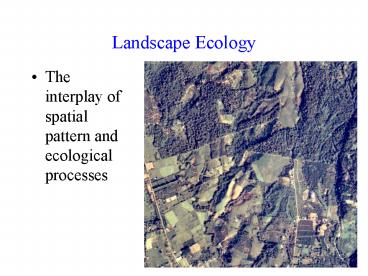Landscape Ecology - PowerPoint PPT Presentation
1 / 36
Title:
Landscape Ecology
Description:
Landscape Ecology. The interplay of spatial pattern and ecological processes ... Usually presented as a graphical depiction of the distribution of sample plots ... – PowerPoint PPT presentation
Number of Views:41
Avg rating:3.0/5.0
Title: Landscape Ecology
1
Landscape Ecology
- The interplay of spatial pattern and ecological
processes
2
Landscape Ecology Outline
- Methods in community description
- Ordination and Classification
- The theory of island biogeography and landscape
ecology
3
Sampling
Methods
- Sampling issues from lab also chapter 9
- BC government, Nature Conservancy, use the relevé
method - Quadrat or transect sampling will give a less
subjective community description
4
Ordination
Methods
- A way to reduce complex, multivariate information
to fewer variables fig 15.3
5
Ordination
Methods
- Many different statistical methodologies
- Usually presented as a graphical depiction of the
distribution of sample plots across an
environmental gradient - Information in graph can be used to develop
testable hypotheses - You should be able to interpret these graphs, and
come up with hypotheses for the patterns
6
Example
Methods
- Garry Oak Ecosystem is highly fragmented
7
Example
Methods
Road Density
Plant Density Diversity
Rockiness
Area
Habitat
Data Lisa Neame
8
Example 2
Methods
Filled circles late succession Open circles
early succession
9
Example 3
Methods
- Pollen data from 190 sites from the different BEC
zones (compiled by S. Goring)
10
Classification
Methods
- Term used similarly to usage in evolutionary
biology - Concept of classification predates ordination
- Similar stands are grouped together on the basis
of physiognomy and presence/absence
11
Classification
Methods
12
Classification
Methods
- Can be used for designating conservation areas or
identifying indicator species - Basically involves either visually or
computationally forming clusters within data - Example Pinus contorta stands in Banff and
Jasper
13
Methods
Fig 15.7
14
Problem 3, Part 1
- According to this figure, which PCA factor is
most important for distinguishing among the
community types, and why?
J. of the Torrey Bot. Soc. 12744-50
15
Problem 3, Part 2
- Beech has a very low tolerance for fire, unlike
oak and pine. Interpret the figure ecologically
utilizing this information and the information
from the caption.
16
The theory of island biogeography
Island biogeography
- MacArthur and Wilson, 1967
- Observation as area increases, species richness
increases
Crawley fig 19.1 Vascular plant diversity
17
The theory of island biogeography
Island biogeography
- Theory islands will have an equilibrium number
of species determined by immigration and local
extinction - Important factors
- Size of island (affects extinction)
- Distance from mainland (affects immigration)
18
The theory of island biogeography
Island biogeography
A1, A2 same distance from mainland A1, A3 same
size C is wrong! Immigration curves should be
identical
T3
T1
T
T1
T2
Fig 16.9 Size affects extinction, Distance
affects immigration
19
The theory of island biogeography
Island biogeography
- Predict higher equilibrium species number on
large, near islands - Predict greater species turnover on near, small
islands - Islands can be of many types
- Oceanic islands, sky islands, habitat islands,
serpentine islands, bogs, lakes
20
Beyond the basics
Island biogeography
- The basic model is criticized for being too
simple - Several authors have suggested extensions of the
theory two are conflated with MacArthur and
Wilsons model in the book
21
Beyond the basics
Island biogeography
- Curves may be nonlinear
- Due to species interactions that change with
density, differences in dispersal ability - Fig 16.14
22
Small Island Effect
Niering 1963. Ecological Monographs 33131-160.
23
Island Biogeography Beyond the basics
Island biogeography
- Rescue effect
- Distance may also affect probability of
extinction - Observation probability of extinction lower for
near (vs. far) islands - Mechanism?
- Prediction for species turnover?
24
Rescue effect
Island biogeography
25
Island Biogeography Beyond the basics
Island biogeography
- Target effect
- Area may also effect probability of immigration
- Observation probability of immigration higher
for large (vs. small) islands - Mechanism?
- Prediction for species turnover?
26
Target effect
Island biogeography
27
Target Effect
J. Biogeography 13 69-70
28
Differential Immigration
Bush Whittaker 191. Journal Biogeography 18
341-356
29
Some evidence supporting MacArthur Wilson
Island biogeography
Greater turnover on near, small patches
Fig 16.15
30
Weaknesses of the theory
Island biogeography
- Does not work well for island types other than
oceanic - Many plants have low rates of immigration/extincti
on over time - Many landscapes a mosaic of patches that change
in availability to particular species over
successional time - Only looks at species richness
31
Island Biogeography and Habitat fragmentation
Island biogeography
- Classic example removal of forest
- Results in species loss due to reduction of area
of remaining fragments - May have other impacts ease of invasion by
weeds, loss of mutualists, abiotic effects of
patchiness, loss of genetic diversity
32
Example fragmentation in Eastern forests
Island biogeography
- Smaller stands have reduced species richness
- Smaller Trillium populations have reduced genetic
diversity
Closed circles primary forest Open circles
secondary forest
Vellend, 2004. Ecology 85 3043-3055
33
Example Fragmentation of the Garry Oak
Ecosystem, Bee Diversity and Pollination Services
Island biogeography
34
Island Biogeography and Reserve design
Island biogeography
- Considered important from the landscape
perspective - Edge to area ratio
- Corridors/connectivity
- Total area
- Distance between sources (mainland) and sinks
(islands)
35
Island biogeography
BETTER WORSE
36
Island Biogeography and Landscape EcologySummary
Island biogeography
- Multi-community landscape studies are complex,
and so sophisticated analytical techniques are
needed to interpret data - Island biogeography theory (plus extensions like
the rescue and target effects) makes predictions
about species richness in different fragments,
and can also be applied to genetic diversity
issues - Island biogeography can inform conservation
decisions































